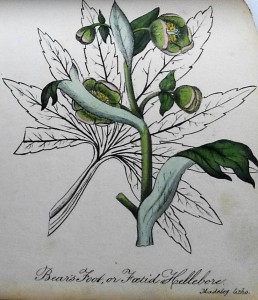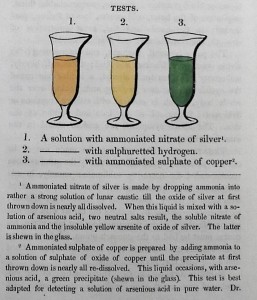This post is part of an ongoing series featuring items recently cataloged from the Julio Mario Santo Domingo Collection.
 I have to say as we have processed this immense collection one of the things that never ceases to delight me are the names of various plants. For example Bear’s foot, which is named because it has an extremely fetid smell, which only leads me to wonder how does one get close enough to a bear to smell its foot? Is this a common occurrence for botanists? The leaves from bear’s foot are very bitter and acrid so if chewed it will actually abrade the mouth. Why might you be chewing the leaves? The leaves will cause vomiting so in the past it was administered to children to expel round worm, but is counseled against in this text because it can be dangerous when given too high of a dosage.
I have to say as we have processed this immense collection one of the things that never ceases to delight me are the names of various plants. For example Bear’s foot, which is named because it has an extremely fetid smell, which only leads me to wonder how does one get close enough to a bear to smell its foot? Is this a common occurrence for botanists? The leaves from bear’s foot are very bitter and acrid so if chewed it will actually abrade the mouth. Why might you be chewing the leaves? The leaves will cause vomiting so in the past it was administered to children to expel round worm, but is counseled against in this text because it can be dangerous when given too high of a dosage.
 Authored by George Spratt, a surgeon, the Medico-botanical pocket-book was published in London around 1836. It is a pocket sized reference tool containing plates that illustrate specific plants, some of which are beautifully hand colored. The cardinal flower which is native to Virginia was introduced to America by the botanist Ray. The root of this plant has a taste resembling tobacco and in the not too distant past it was often used to help treat fever sores, cramps, and again induce vomiting if one ate something poisonous. Apparently the Native Americans often used cardinal flower for both medicinal and ritual usage. It was both used as a type of ceremonial tobacco and thrown to the winds to ward off storms as well as an ingredient in love charms.
Authored by George Spratt, a surgeon, the Medico-botanical pocket-book was published in London around 1836. It is a pocket sized reference tool containing plates that illustrate specific plants, some of which are beautifully hand colored. The cardinal flower which is native to Virginia was introduced to America by the botanist Ray. The root of this plant has a taste resembling tobacco and in the not too distant past it was often used to help treat fever sores, cramps, and again induce vomiting if one ate something poisonous. Apparently the Native Americans often used cardinal flower for both medicinal and ritual usage. It was both used as a type of ceremonial tobacco and thrown to the winds to ward off storms as well as an ingredient in love charms.
Something that was unexpected in this volume was the appendix which relates information about poisons. This section gives diagnostic and general symptoms, treatment, and morbid appearances. Included are various tests for each poison complete with these amazing little drawings that illustrate the experiments. This particular illustration displays how to test for arsenic in various chemical compounds and the actual colors that result when arsenic is present in them.
The medico-botanical pocket-book : comprising a compendium of vegetable toxicology … ; to which is added an appendix, containing practical observations on some of the mineral and other poisons, illustrated with tests / by G. Spratt. London : Published for the author by J. Churchill, [1836]. Pp Sp7m 1836. can be found in the Botany Libraries.
Thanks to Alison Harris, Santo Domingo Project Manager, Gretchen Wade, Judith Warnement, and Chris Robson of the Botany Libraries for contributing to this post.

